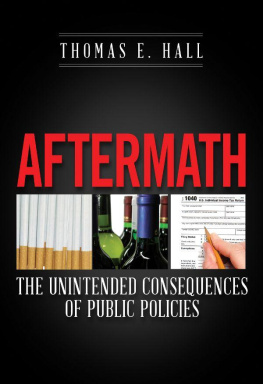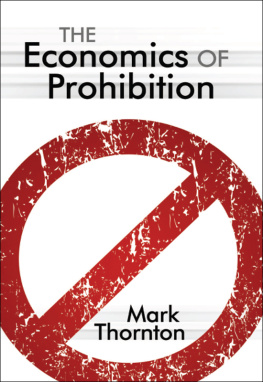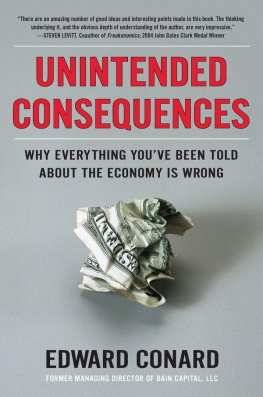
Copyright 2014 by the Cato Institute.
All rights reserved.
Library of Congress Cataloging-in-Publication Data
Hall, Thomas E. (Thomas Emerson), 1954
Aftermath : the unintended consequences of public policies / Thomas E. Hall.
pages cm
Includes bibliographical references.
ISBN 978-1-939709-38-7 (hardback : alk. paper) 1. Policy sciencesUnited StatesCase studies. 2. Political planningUnited StatesCase studies. 3. Income taxUnited States. 4. CigarettesTaxationUnited States. 5. Minimum wageUnited States. 6. ProhibitionUnited States. I. Title.
JK468.P64H36 2014
320.60973--dc23
Ebook ISBN: 978-1-939709-39-4
2014017681
Printed in the United States of America.
Cover design: Jon Meyers
CATO INSTITUTE
1000 Massachusetts Ave., N.W.
Washington, D.C. 20001
www.cato.org
To the memory of my brother Jim
Contents
Figures
Tables
This book describes four case studies of the law of unintended consequences as it applies to government policy. The well-known result that government policies designed to bring about one set of goals often create unanticipated outcomes has taken on increasing importance as governments become ever more involved in social and economic affairs.
I became interested in this topic while researching 20th-century U.S. macroeconomic policies. My studies of business cycles, the Great Depression (with J. D. Ferguson), and the perverse economic policies carried out during the presidencies of Richard Nixon and Jimmy Carter convinced me that most of the macroeconomic instability experienced by the United States had resulted from poorly designed government policies. I then began to consider the effects of policies targeted toward more specific issues (as opposed to the overall macroeconomy). Abundant examples of the law of unintended consequences exist; the hard part was choosing a small group to focus on.
The four cases described in this book are, I believe, interesting and important and will prove enduring. The federal income tax has existed since 1913, and given the desire of the middle and lower classes that the rich pay their fair share, the income tax will almost certainly continue to play a major role for years to come. Cigarette taxes have been around since the 1860s and will likely be with us for as long as people smoke cigarettes. State minimum wage laws first appeared in the early 1900s, and the original federal law was put in place in 1933 as part of the New Deal. Given the ongoing demands that workers should earn a living wage, we can expect minimum wage supporters to advocate not only for keeping the law but for continuing increases in the minimum wage. The final case is alcohol Prohibition. Although it ended in 1933 because the unintended consequences were so devastating, it has major applications to the war on drugs, which has been an explicit policy of the U.S. federal government since the early 1970s.
Several individuals assisted on this project. J. David Ferguson, D. Christopher Ferguson, William Hart, and Kenneth Ashley read drafts of chapters and offered valuable comments. I also benefited greatly from discussions with Charles Moul, James Brock, and Michael Winrow on a variety of topics. Graduate students Matt Mauck, Neel Shivdasani, and Heather McHone proofread and checked references. And my wife Christine read chapters and made comments, along with providing a loving and supportive environment. Any errors are my responsibility. Financial support for this project was provided by Miami University.
This book is dedicated to the memory of my late brother, James Ashley Hall.
While driving along a residential street in the United States, you can often tell which homes are occupied by their owners and which by renters. Usually, but not always, the owner-occupied houses are better maintained, the lawns are well tended, and there is an absence of clutter on the property. Rentals often have a rougher appearance. The main reason for this difference is that owner-occupiers have a strong incentive to take care of their house and land because they live there. Absentee landlords maintain properties, but their incentive to do so is lessened somewhat since they do not occupy the premises. Tenants have even less incentive to be concerned with maintenance.
The benefits to society from homeownership are well known. In addition to the maintenance factor, owner-occupiers have a greater vested interest in the well-being of their community. They are more likely to care about the quality of local schools, roads, and parks. Homeowners are also more stable residents in the sense that they move less often than renters. Also, since house prices have generally risen over time, homeownership has helped raise Americans wealth. With these points in mind, wouldnt it be great if all American families owned their own home?
The advantages of homeownership have long been accepted in the United States, which is why the U.S. government pursues policies to promote it. This effort began in earnest during the 1930s when President Franklin Roosevelts New Deal created various programs and agencies that encouraged homeownership: the Federal Housing Administration to insure home mortgages; the Federal National Mortgage Association (Fannie Mae) to buy mortgages insured by the Veterans Administration; the Federal Home Loan Banks to provide assistance to the savings and loan industry, which was the primary source of mortgage lending; the promotion of 30-year mortgages to lower monthly payments and make homes more affordable; the Home Owners Loan Corporation that refinanced mortgages in default. In addition, since its inception the federal income tax code has allowed the deduction of mortgage interest from income when calculating taxes. Due in part to these various government programs, the U.S. homeownership rate, which is the proportion of U.S. houses occupied by their owners, rose from 44 percent in 1940 to 63 percent in 1970.
After 1970, the growth of homeownership slowed, reaching 66 percent in 1980 before dropping back to 64 percent by the mid-1980s. It remained at that level for roughly the next 10 years. During that time, some Americans expressed concerns that homeownership was not equal across racial groups. Citing the fact that homeownership was more prevalent among whites than nonwhites, banks were accused of redlining, an alleged practice whereby they do not issue loans to individuals or businesses in certain sections of cities. Since minorities disproportionately occupied the areas where redlining was said to be taking place, the implication was that banks were practicing discriminatory lending. This claim received support in 1992 when the Federal Reserve Bank of Boston released an influential study that reported that black and Hispanic mortgage applicants in the Boston area were more likely to be turned down than white applicants with similar characteristics (Munnell et al. 1992, 42).
Evidence of discriminatory lending and the implication that minorities were being excluded from homeownership led to enhanced efforts by the U.S. federal government to promote home buying. In 1992, Congress passed the Housing and Community Development Act, which essentially gave [the Federal National Mortgage Association (Fannie Mae) and the Federal Home Loan Mortgage Corporation (Freddie Mac)] a mandate to purchase lower-quality mortgages (Acharya et al. 2011, 32). Fannie Mae and Freddie Mac are government-sponsored enterprises that purchase mortgages; after 1992, they bought increasing quantities of subprime mortgages, which are loans to higher-risk borrowers. Another important factor was the 1995 amendment to the Community Reinvestment Act, which urged banks to increase lending to low-income Americans. If banks failed to meet the standards they were not subject to explicit penalties, but lending data would be made available to community groups. The implied threat was that if banks did not step up lending to minorities, then community groups would find out and organize protests and boycotts of the banks.
Next page









